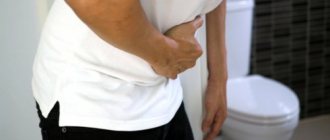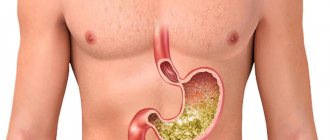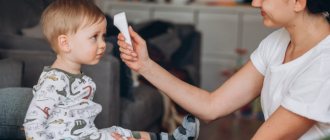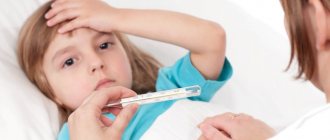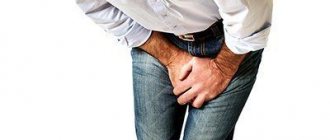Our children are very inquisitive and curious. They explore the world and try to taste everything. Unfortunately, children's curiosity and parental inattention often become a harbinger of trouble - poisoning in a child.
If medicines, cosmetics or household chemicals are stored at home in a place accessible to children, the child may try them, tempted by the bright packaging or delicious smell. Alas, often the result of such a “tasting” can be poisoning of a child.
Danger awaits children in the lap of nature: fragrant flowers, berries, bright mushroom caps also cause poisoning of children who eat this “beauty.”
Food poisoning in a child occurs when eating poor-quality food or products contaminated with microorganisms or fungi.
Mass poisonings, such as salmonellosis, also occur in children's groups.
In adolescence, there is a desire to “try everything” - toxic substances, medications, and sometimes drugs. Such experiments often end in acute poisoning of the child or substance abuse (drug addiction).
Poisoning in a child is divided into periods:
- asymptomatic period - the time from the moment a toxic substance enters the body until the initial manifestations of poisoning (fever, vomiting, diarrhea);
- intoxication is the period from the moment when the poison has already been absorbed into the blood until the toxic substance is completely removed from the body. It is at this stage that it is important to provide timely and correct assistance to the child. Otherwise, dysfunction of various internal organs and the brain is possible.
After poisoning, a child may experience insidious consequences - complications: kidney or liver failure, disorders of the nervous system, heart, lungs.
After food poisoning, the functioning of internal organs is restored. The duration of the period depends on the severity of intoxication, timeliness of treatment and concomitant diseases of the child.
Signs of poisoning
Doctors regard a sudden deterioration in the child’s health – vomiting and diarrhea – as possible poisoning of children.
However, the symptoms in a child depend not only on the body’s “desire” to remove the poison, but also on the toxic properties of the substance itself that is ingested:
- vomiting without diarrhea may be a sign of nicotine poisoning;
- dilation of the pupils occurs with alcohol poisoning;
- nystagmus or strabismus - in case of fly agaric poisoning;
- constricted pupils are a sign of opiate poisoning;
- impaired color perception - carbon monoxide poisoning;
- paralysis, double vision - symptoms of botulism;
- blindness - methyl alcohol poisoning;
- diarrhea, abdominal pain and vomiting accompany food poisoning. When food is contaminated with bacteria, the temperature rises. In case of poisoning, a child experiences headache, drowsiness, and poor appetite.
Sources
- Novikova V.P., Gurova M.M., Khavkin A.I. Functional nausea and vomiting in children. Questions of children's dietetics. 2020; 18(4): 36–44
- Dubrovskaya M.I., Mukhina Yu.G., Shumilov P.V., & Volodina I.I. (2007). Regurgitation and vomiting syndrome in children of the first year of life: differential diagnosis and management tactics. Pediatrics. Journal named after G.N. Speransky, 86 (6), 18.
- Forbes D., Fairbrother S. Cyclic nausea and vomiting in childhood // Aust. Fam. Physician. - 2008. - 37(1-2).
- Boles R., Powers A., Adams K. Cyclic Vomiting Syndrome Plus // J. Child Neuro. - 2006. - 21(3).
- Muminova D.A. “Nosoological structure of recurrent vomiting in children” FORCIPE, no. Application, 2021, pp. 269-270.
How to treat poisoning in a child?
Therapy consists of main areas:
- Prevent the absorption of poison into the blood;
- Application of an antidote (antidote);
- Removing toxic compounds from the body;
- Treatment of symptoms of poisoning.
Difficulties in treating children under one year of age are associated with insufficient function of the kidneys and liver, the organs responsible for neutralizing toxins and removing them from the body.
It is important to know
Regardless of the type of plant poison, it is necessary to begin treating poisoning in children with gastric lavage.
The volume of water required for rinsing: 3 years - 6 years: take 16 ml of water per kilogram of child’s weight, 7 years and older - 14 ml per kilogram of weight. After emptying the stomach of food debris, give the child Enterosgel sorbent.
Poisoning in children should be treated as quickly as possible. Before the doctor arrives, it is necessary to compensate for the fluid lost through vomiting and diarrhea - to give the baby a drink. This will also quickly remove toxins from the body. Drinks are given a few teaspoons every 5-10 minutes.
Pharmaceutical solutions (rehydron and others), boiled water, carrot-rice or raisin infusions are used.
Fever in case of poisoning in a child is eliminated by taking antipyretic drugs.
If the baby is breastfed, in addition to milk, you should give him boiled water. And after some time after food poisoning, you can return to your normal feeding regimen.
Food poisoning in a child with mushrooms, poisonous plants, and chemicals is treated in a hospital setting.
What complications cause vomiting and diarrhea in a child?
We have already found out what to do if a child has a stomach ache and vomiting without a fever. However, if timely treatment is ignored, complications may arise.
The peculiarity of vomiting without an increase in body temperature is not a disease, but only a symptom of it. This pathology itself will not cause any complications. However, it may indicate the presence of serious diseases of the digestive system.
Such diseases can appear if treatment for the symptoms that caused the vomiting is not started in time. In many cases, the complications are quite serious, so it is better to hurry up and visit a doctor.
If vomiting continues for a long time, dehydration and weakening of the body cannot be avoided. Under the supervision of a doctor, it is necessary to give the child all the medications he prescribes. You should not self-medicate - this may not give any effect, or even lead to the opposite result.
Diet for poisoning in a child
You need to start diet therapy with fasting. A child under 1 year of age who is breastfed misses several feedings. For older children, food is offered after the vomiting disappears.
What to feed a child if he is poisoned?
Food should be gentle on the stomach and intestines - this is a mandatory requirement for dietary dishes.
Pediatricians know what to feed a child in case of poisoning in order to provide the body with nutrients and enable it to recover from intoxication. Children who previously received complementary foods are given rice or buckwheat porridge prepared with milk and water in equal proportions. The porridge is pureed and diluted with hot milk. After a few days, you can give pureed vegetables. After 3-4 days - baby cottage cheese. Gradually, fish and meat are introduced into the diet in the form of a soufflé.
Children over one year old can be given biokefir or bioyogurt: they will ensure the restoration of the microflora of the large intestine after intoxication. The diet is expanding faster. Soups, purees, meat, fish, cereals are rubbed through a sieve.
What can a child eat if he is poisoned while vomiting?
To maintain water-salt balance, the baby should be given tea, rosehip decoction, salted or mineral water, and dried fruit compote. Feed only after vomiting has stopped.
Pediatrician Komarovsky believes that you should not force feed a child. Dishes on the children's menu should contain vitamins and be easy to digest, and drinks should be rich.
What can you eat if you are poisoned during diarrhea?
The menu should not include products that have a laxative effect and increase gas formation. During this period you cannot: baked goods, whole milk, brown bread.
Depending on the diagnosis, main symptoms, and diet treatment may vary significantly. In some cases, therapeutic fasting is recommended. After it, homemade crackers, oatmeal and rice porridge are gradually introduced. The first day the baby is fed often in small portions.
- What is allowed to eat? You can have mashed potatoes, rice porridge, white crackers, tea.
- What is strictly prohibited: fresh baked goods, pasta, chocolate, ice cream, chips.
The diet should be followed for about two weeks, then the child gradually returns to the regular menu.
Treatment
Regardless of the cause, medications that relieve attacks of nausea are first prescribed. Psychotherapy plays a major role in the treatment of psychogenic vomiting in a child. A psychologist works with the patient. Diet therapy is prescribed to restore the body’s full supply of necessary substances and energy. The “Center for the Study of Eating Disorders” in Moscow assigns an important role in treatment to diet. The diet is tailored to the individual needs and characteristics of the patient. Our specialists provide psychiatric care in inpatient and outpatient settings. There is an intensive care service for seriously ill patients.
What to feed a child after poisoning?
Dishes are warm, pureed or served in crushed form - rubbed through a sieve or processed in a blender.
What can you eat after poisoning? Ready-made baby products are perfect for this: meat and fish soufflés, vegetable purees, porridge or home-cooked boiled or steamed dishes. On the contrary, you should exclude: cucumbers, tomatoes, cabbage, wheat, pearl barley porridge.
What can you eat after a period of intoxication? During the recovery period, the menu consists of: boiled chicken meat, buckwheat porridge, natural yogurt, low-fat fish, kefir.
Diet period - 2-3 weeks from the moment of poisoning in children.
Treatment at home with the help of dietary nutrition will help to avoid chronic diseases of the digestive system and other complications.
Now let's talk about what to do while you are waiting for the doctor. So…
First aid for child poisoning
Parents should be able to provide first aid to their child in case of poisoning before the ambulance arrives. This will help prevent the absorption of the toxic substance and reduce intoxication.
In case of poisoning with mushrooms, berries or medications, it is necessary to induce vomiting in the child by pressing on the root of the tongue. Rinse the stomach with a warm solution of table salt (2 - 4 teaspoons of salt per 1 glass of water) until the rinsing water is clean. The volume of liquid for gastric lavage should not be more than 3 liters.
What to give a child if he is poisoned?
After gastric lavage, enterosorbents are introduced inside to absorb the remaining poison.
They should be used as first aid for any food poisoning! But at the same time, it is necessary to know the permissible dosages and the preferred dosage form of the sorbent. For example, traditional activated carbon can damage the stomach lining of young children.
Modern silicon-containing sorbents (for example, Enterosgel) have high sorption activity, are available in gel form and are successfully used in pediatrics. Enterosgel absorbs not only pathogenic bacterial cells, but also their toxins, secondary mediators of inflammation, does not linger in the digestive system, is not absorbed, is suitable for long-term therapy and does not stain the stool, which is especially important during diagnosis.
What happens during vomiting?
Vomiting is a protective reflex in which the contents of the stomach and initial parts of the intestines are returned through the mouth.
As a rule, it is preceded by nausea. It is caused by irritation of the receptors of the gastrointestinal tract (GIT) or a direct effect on the vomiting center, which is located in the brain stem. The gag reflex is realized by contracting the diaphragm, intercostal and abdominal muscles with the simultaneous opening of the lower esophageal sphincter, which normally prevents the return of food from the stomach into the esophagus. At the same time, the epiglottis closes and breathing stops, which prevents vomit from entering the respiratory tract.
As a result, the contents of the stomach, including enzymes and fluid, leave the body through the oral cavity. Also, due to the activation of the autonomic nervous system, salivation increases and sweating occurs. All this leads to loss of fluid - dehydration, which becomes a serious problem with prolonged vomiting.
How to take Enterosgel for children?
Children are recommended to take Enterosgel 3 times a day:
- 5 – 14 years – dessert spoon;
- 2 years - 5 years - tea.
- In case of severe acute poisoning, doctors allow a dosage to be doubled.
Enterosgel should be in every home medicine cabinet, especially in summer!
A few hours later, already in the hospital, the doctors repeat gastric lavage for the child, after which they give a saline laxative (magnesium sulfate in a dose of 15 - 20 g in 100 ml of water).
If the cause of intoxication is reliably known - in the early period of poisoning, antidote therapy is carried out - an antidote is introduced into the body. For example, ethyl alcohol is used for wood alcohol poisoning, the mushroom venom of the toadstool is neutralized with lipoic acid, and for poisonous snake bites, a specific anti-snake serum is administered.
Removal of poison absorbed into the blood is carried out using forced diuresis (administration of fluids during diuretic therapy), hemosorption, plasmapheresis, hemodialysis.
In case of violations of the vital functions of the body, treatment of convulsive syndrome, a complex of anti-shock measures, etc. are carried out.
Diagnostic methods
Before prescribing a course of treatment, the psychogenic nature of the gag reflex is clarified. With similar symptoms, childhood diseases that cause nausea are diagnosed: chicken pox, measles, scarlet fever, mumps. An experienced doctor determines their presence or absence by the manifestation of characteristic symptoms: rash, swelling, red spots on the skin. To identify the disorder, the doctor asks the child and parents a number of questions:
- does vomiting cause discomfort?
- whether treatment was carried out with antibiotics and other toxic drugs;
- what is the emotional state of the child;
- parameters of the daily routine - duration of sleep, study, rest;
- when and under what circumstances attacks occur;
- Do you feel sick in the morning?
To determine the severity of a psychogenic disorder, the following is carried out:
- MRI of the brain - the parameters of the secretory glands, membranes, and the difference in neuron potentials are examined;
- encephalogram – the dynamics of the passage of nerve impulses, a complex picture of reactions to stimuli;
- biochemical blood test for hormonal activity.
If the disease is not an eating disorder, we refer the patient for further examination and treatment to a gastroenterologist or endocrinologist. We also accept patients from other medical institutions with a diagnosis of eating disorder or symptoms similar to this mental disorder, if treatment for other diseases has led to eating disorder.
How to avoid poisoning?
- The child should be taught to wash his hands after visiting the toilet and before eating. Eat only washed vegetables and fruits;
- parents follow the rules for storing and preparing food;
- you cannot buy products of dubious quality in spontaneous markets and stores;
- you should not cook for future use in the summer months;
- when bathing children in ponds, it is worth remembering that pathogens of intestinal infections can live there;
- do not allow children to pick berries and mushrooms without adult supervision;
- do not feed mushroom dishes to children under 7 years of age;
- Medicines and various chemicals must be stored exclusively out of the reach of children.
Health to you and your child!

